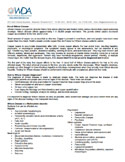Publications provided by the Wilson Disease Association
To download them in PDF format, click below.
 |
Understanding Wilson DiseaseSupport & Empower People Affected by Wilson Disease |
|
 |
NEW! About Wilson Disease.General information about WD and the WDA .
|
|
 |
Unexplained hepatic, neurologic, or psychiatric symptoms?Think Wilson disease.
Algorithms for assessment of Wilson disease.
A Diagnostic Tool for Physicians.
Wilson Disease Association. Rev. August, 2009 [PDF]
|
|
 |
A diagnosis of Wilson disease – what now? Treatment and management.A Clinical Tool for Physicians.
Wilson Disease Association. September, 2005 [PDF]
|
|
 |
Published in March, 2008, this 8 1/2" x 11", 32 page publication includes the topics: Medical Care, Medications, Diet and Nutrition, Special Circumstances, and Family Concerns and Genetics. Also included is a glossary of medical terms, a glossary of genetic terms, and a printed copy of the "Wilson Disease Patient Lab Tracker". |
|
Evaluating Diagnosis and Management Gaps in Wilson DiseaseResults from a qualitative patient survey. Tamir Miloh, Baylor College of Medicine, Houston, Texas |
If you would like a copy, please contact the WDA office at: This email address is being protected from spambots. You need JavaScript enabled to view it. or 866.961.0533.




